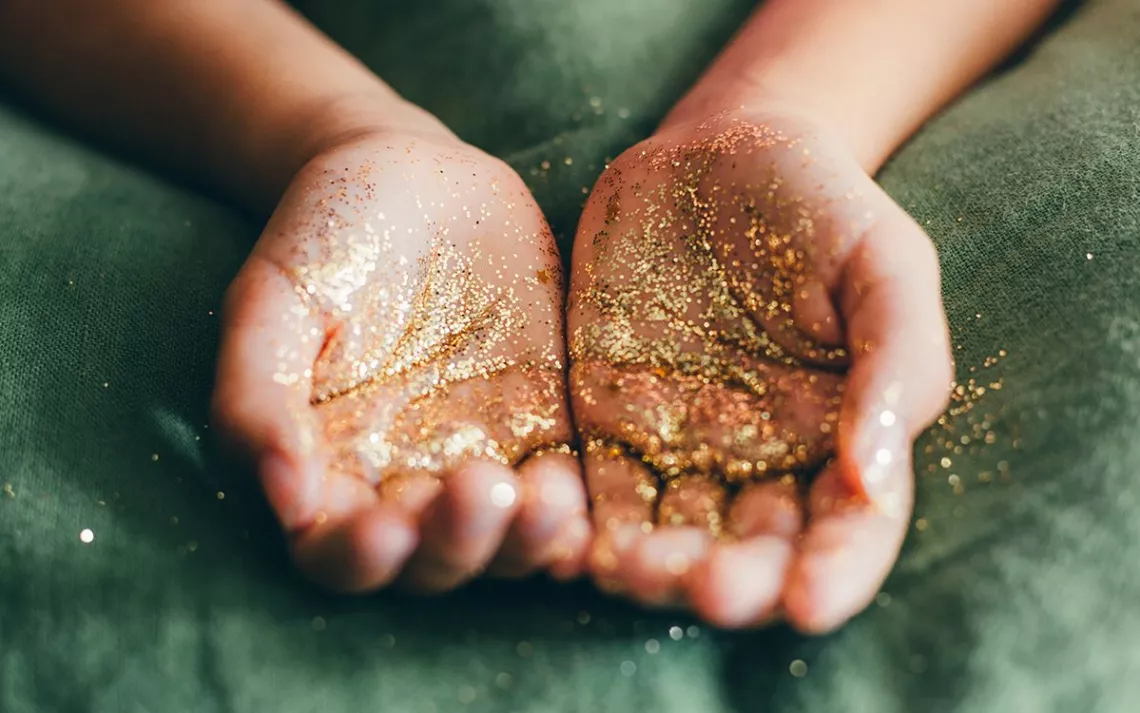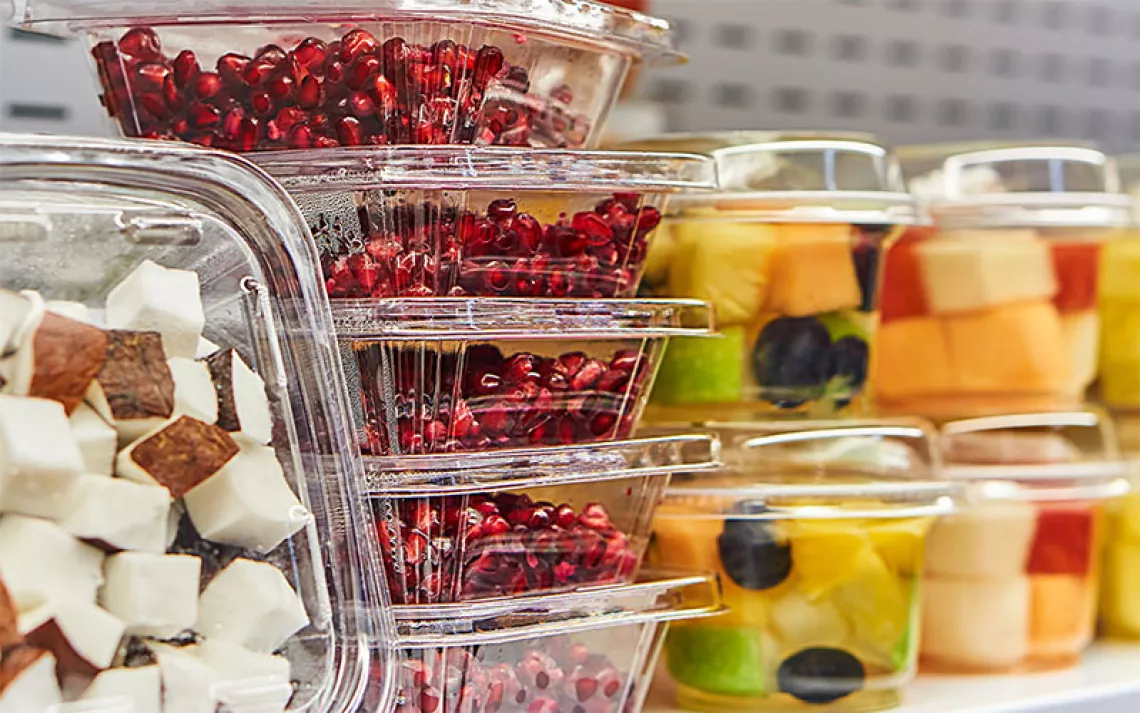One Parent’s Harrowing Encounter With Microplastic
Why plastic pollution is a lot like glitter, and what we can do about it
A few weeks ago, a blue speck of glitter migrated from a microplastic-splattered sheet of tissue paper to the white of my infant’s eye. The discovery horrified me, as it would most parents. But what I found particularly disturbing was the fact that the same thing once happened to me.
Years before the word “microplastic'' became commonplace, an optometrist plucked a shiny shard of aquamarine glitter from my eyeball. It had penetrated my cornea the night before while I was crafting. In less than 24 hours, the tiny offender had rendered my eye useless, and if not for modern medicine, a numbing agent, a terrifying set of tweezers, and an adept doctor, it's quite possible I'd be half-blind today.
As a child, my mother warned me of this very possibility every time I played with glitter, but I never thought it would actually happen. And yet, there it was, a shining symbol of the Anthropocene twinkling back at me from my two-month-old’s innocent gaze.
Of course, I blamed myself. “It matches her eyes,” my husband said when I frantically pointed out the spot. Though he managed to stay calm as we watched the sparkle slip in and out of sight with each blink, my panic mounted. How would a professional extract it? Would my daughter have to undergo surgery? Could she lose her vision? Or even worse, her eye?
After much discussion and several unsuccessful swoops for the tinsel, we agreed to simply monitor it. The hospital, if needed, was just 20 minutes away. I continued to check her obsessively until we went to bed that night, noting the glitter had drifted toward her tear duct before disappearing from view.
But the next morning, soft light shone across her crib when she woke at dawn, happy and alert—and the gleaming cobalt circle was back. Soon after, it came out on its own, discarded by her body onto her lower eyelid. I stuffed it into a tissue and flushed it down the toilet like I would a tick. Out of the house, into the septic tank, through the leach field, buried beneath the ground. Gone but not away.
That’s the thing with plastic. It doesn’t vanish—it breaks down.
While what happened to us may seem unlucky, like some bizarre manifestation of my mother’s glitter curse, microplastic is entering the body all the time. We just don't normally see the tiny particles—defined as fragments less than five millimeters in diameter—that are ingested with our food and drinks, via the air we breathe, and even through our skin. And we aren’t the only ones.
The negative impact of plastic pollution on the animal kingdom has become well-known. Images of sea turtles with straws lodged in their noses, seahorses gripping Q-tips, and creatures of all sizes found full of plastic, from mussels to albatross chicks to whales, have reached billions of people across the planet.
Even when out of sight, plastic is all around us, permeating everything from Arctic sea ice to the ocean floor, and with its ability to slip through water filtration systems, even the human womb is no longer safe, according to a 2020 study that found microplastic particles in the placentas of unborn babies. Pieces of our insatiable consumption derived from everyday items: cosmetics, finger paints, personal care products, and of course, glitter. Plastic isn’t just deeply ingrained in our culture, it’s becoming a part of us, burrowing its way into our flesh, in some cases our eyes.
Today, people are consuming the weight of a 4x2-inch Lego block of plastic per month. And that amount is only likely to increase with production, which is on track to triple by 2040—up from 303 million tons generated annually.
Though most plastics take hundreds of years to biodegrade, humanity continues to churn them out at record rates, year after year. Over 8.3 billion tons of plastic—the equivalent of 80 million blue whales—have been produced since the 1950s, all of which remain in one form or another in the environment today, chipping from candy wrappers and water bottles into microplastics and nanoplastics small enough to be absorbed by human cells. So much so that ocean plastic is expected to outweigh fish by 2050.
Any way you look at it, Earth’s transformation to Planet Plastic seems nearly impossible to avoid. So, why make such a big deal about glitter?
That’s what people have been wondering since 2017, when a British preschool chain outlawed the substance, prompting international discussion of a global ban on the glitz. On the macro level, glitter makes up less than 1 percent of all plastic pollution. But microscopy tells a different story, because what makes glitter so dangerous lies in its very design.
Unlike most microplastic particles, which are created when larger plastic products break down, glitter is a ready-made microplastic. Meaning it doesn't require any additional time to transition into one of the most harmful forms of plastic on the planet. That’s why companies and consumers alike are increasingly turning to “eco-friendly glitter.”
Unfortunately, a first-of-its-kind study revealed that biodegradable or eco-glitter isn’t as innocuous as it sounds. Frequently found in cosmetics and crafts, so-called eco-glitter often meets freshwater systems when it’s washed off of tiny hands and painted faces or blown away in the breeze. Last year, researchers from Anglia Ruskin University confirmed that both conventional plastic glitter, made from PET, and eco-friendly glitter, fashioned from mica and other composite materials, are equally damaging to life at the base of the food web in rivers and lakes.
While that’s bad news for everybody, some companies are stepping up to meet the moment. Instead of putting the onus on consumers to simply reduce, reuse, and recycle our way out of the plastic crisis, three British retailers last holiday season committed to removing glitter altogether from cards, crackers, wrapping paper, gift bags, and other products. Though such changes could go a long way if replicated by retail chains the world over, it will take much more than piecemeal bans on single-use plastics to clean up this mess.
That’s what makes the pioneering Break Free From Plastic Pollution Act, introduced to Congress in March, so critical and promising. A global plastic treaty supported by more than two-thirds of UN member states and major brands like Nestlé, Coca-Cola, PepsiCo, Starbucks, and Unilever would also carry broad, sweeping effects.
In the US, the Break Free From Plastic Pollution Act would push corporate responsibility for plastic production, tighten regulations, phase out unnecessary products, create a new standard for labeling, and ease the burden befalling frontline communities. A global plastic treaty would take the commitment even further by mandating national targets and action plans, harmonizing international definitions and regulatory standards, establishing global reporting metrics, and funding waste management facilities where they’re needed most.
Governments, businesses, and people are increasingly realizing that corporate accountability is necessary to actualize meaningful progress. No longer can we allow slick marketing campaigns funded by the plastic and fossil fuel industries to place all the impetus on the masses to solve this scourge through a failed recycling system, “better” choices, and eco guilt.
This isn't to say individual actions don’t matter—they of course do. Consumers have to be willing to shed our complacency, complicity, and addiction to convenience to be better stewards. That includes standing up to the powers perpetuating this calamity and reconsidering our relationship with particularly flashy forms of litter, especially when it comes to our kids. Because the glitter curse wasn’t cast just on my house—it affects us all.
As a parent, I can’t help but be hard on myself for my own consumption when I consider that up to 20 generations of my descendants could inherit a world defiled by the plastic used in my lifetime. Even that sapphire fleck flushed down the toilet in a frenzy to save my daughter’s eye will have a long-standing, as-yet-unknown impact. Everything in life does. That’s why we desperately need responsible options for disposing of plastics. A UN treaty driving the transition to a circular economy for this highly polluting commodity could do just that.
Glitter may be little more than another snowflake on the tip of the proverbial plastic iceberg, but it’s also a fitting symbol for this blight—it’s harmful, gets everywhere, and is impossible to clean up, and yet we remain so stubbornly beguiled by its shine.
 The Magazine of The Sierra Club
The Magazine of The Sierra Club




